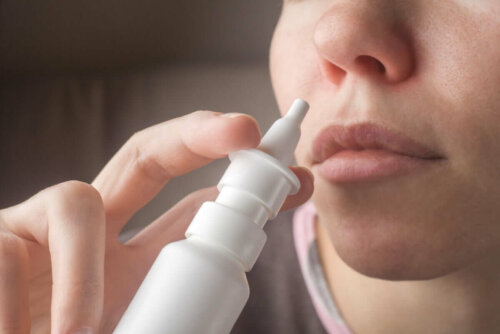Taking Care of a Common Cold at Home


Written and verified by the doctor Elisa Martin Cano
In most cases, taking care of a common cold at home is quite simple. This condition can affect anyone and doesn’t usually cause major complications. Still, its symptoms are bothersome and may lead the person to skip work or school.
Symptoms such as nasal congestion, sneezing, and coughing produce a feeling of general discomfort that hinders the process of doing daily tasks. Fortunately, it usually improves in a short time by adopting self-care measures. Continue reading to learn more!
What’s a common cold?
A common cold refers to a viral infection that affects the respiratory tract. It can be caused by many different types of viruses. Actually, it’s estimated that there are around 200 types of related viruses, such as rhinovirus, adenovirus, and others.
Throughout history, experts have attempted to identify the factors that help this pathology develop. For example, studies have shown that this happens more frequently in children, in stressful situations, or in places where the environment is dry and cold.
Symptoms usually appear two to three days after being exposed to the virus. Let’s see some of them:
- Nasal congestion
- Sneezing
- General discomfort
- Low fever (only in some cases)
- Cough and sore throat
- Headache
The mucus thickens as the disease progresses. However, the symptoms improve on their own within days. Despite that, it’s important to put into practice some tips to cope with it and reduce the risk of complications.

Read also: How to alleviate nasal congestion in under a minute
Tips for taking care of a common cold at home
If there are no signs of complications from a common cold episode, a few simple things are more than enough to cope with the symptoms. Following them, as well as resting appropriately, will relieve the symptoms in a short amount of time.
Drink water and healthy fluids
Keeping yourself hydrated is one of the fundamental measures to relieve congestion. When you drink a lot of fluids, the mucus thickens and becomes easier to remove, either by sneezing or coughing.
We recommend drinking both water and hot infusions. Similarly, soups and broths often create a comforting sensation. It’s important that you avoid substances that promote dehydration, such as alcoholic or caffeinated drinks.
Make a saline solution
Applying a saline solution can help you to improve discomforts such as nasal congestion and throat irritation. It’ll be enough to dilute a quarter of a teaspoon of salt in a glass of warm water. Then, use the liquid to do a nasal wash or gargle.
If you don’t want to do it yourself, you can simply buy a saline spray and nasal drops at the pharmacy. They’re applied in the case of blockage and excess mucus production. In babies, the ideal thing is to apply several drops of the product in one nostril. Then, suck it out carefully with a rubber pear.
Read also: What’s a saline solution used for?

Take care of the place you rest
When it comes to taking care of a common cold at home, one of the most vital aspects is taking lots of rest. However, you must make sure that the place where you sleep is free from irritants, such as cigarette smoke, dust, or strong-smelling chemicals. Exposure to these can worsen your symptoms.
You can also install a humidifier in the room so that the environment is humid and warm. This will help decrease the irritation of the respiratory tract and increase the feeling of relief.
Other things to do to take care of a common cold at home
In addition to putting the above into practice, it’s essential to remember the importance of reducing the risk of contagion. You must cover your nose and mouth when coughing or sneezing to keep the particles of your secretions from infecting others. Washing your hands regularly and avoiding sharing personal items is another useful measure for this.
If you’re suffering from symptoms such as headaches or general malaise, we recommend you take analgesic medications, such as ibuprofen or paracetamol. In addition, there are mucolytic and antitussive drugs that help reduce mucus thickness and cough. In any case, to avoid self-medication, your best bet is to go to the doctor and follow their recommendations.
All cited sources were thoroughly reviewed by our team to ensure their quality, reliability, currency, and validity. The bibliography of this article was considered reliable and of academic or scientific accuracy.
- Bosch, Á. (2003). Cuidado y tratamiento del resfriado. Offarm: farmacia y sociedad, 22(10), 65-72. https://www.elsevier.es/es-revista-offarm-4-articulo-cuidado-tratamiento-del-resfriado-13054399
- Carballal, G., Marcone, D., & Videla, C. (2014). Virus respiratorios emergentes y el nuevo impacto de los rinovirus por medio del diagnóstico molecular. Corpus. https://ri.conicet.gov.ar/handle/11336/103749
- Cleveland Clinic (20 de octubre del 2019). How You Can Tell If You Need a Humidifier. Cleveland Clinic. Consultado el 26 de mayo del 2024. https://health.clevelandclinic.org/how-you-can-tell-if-you-need-a-humidifier
- Mayo Clinic (3 de junio del 2022). Remedios para el resfriado: Qué funciona, qué no y qué no te hace daño. Mayo Clinic. Consultado el 26 de mayo del 2024. https://www.mayoclinic.org/es/diseases-conditions/common-cold/in-depth/cold-remedies/art-20046403
- Pintos , I., Muñez, E., Alarcón, A., & Ramos, A. (2018). Flu virus and respiratory virus infections. Medicine (Spain), 12(56), 3291–3297. https://www.sciencedirect.com/science/article/pii/S0304541218301173?via%3Dihub
- Sociedad Española de Médicos Generales y de Familia (s.f.). Cómo toser y estornudar correctamente. SEMG. Consultado el 26 de mayo del 2024. https://www.semg.es/index.php/component/k2/item/498-como-toser-o-estornudar-correctamente
This text is provided for informational purposes only and does not replace consultation with a professional. If in doubt, consult your specialist.








